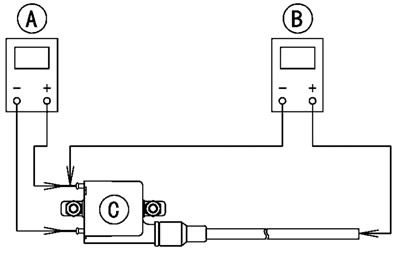Measure the arcing distance with a commercially available coil tester [A] to check the condition of the ignition coil [B].

Connect the ignition coil (with the spark plug cap left attached at the end of the spark plug terminal) to the tester in the manner prescribed by the manufacturer and measure the arcing distance.
3 needle arcing distance:
- Standard: 6 mm (0.24 in.) or more
Warning! To avoid extremely high voltage shocks, do not touch the coil body or leads.
★ If the distance reading is less than the specified value, the ignition coil or spark plug caps are defective.
To determine which part is defective, measure the arcing distance again with the spark plug caps removed from the ignition coil. Remove the caps by turning them counterclockwise.
★ If the arcing distance is subnormal as before, the trouble is with the ignition coil itself. If the arcing distance is now normal, the trouble is with the spark plug cap.
★ If the coil tester is not available, the coil can be checked for a broken or badly shorted winding with the hand tester.
- Special Tool - Hand Tester: 57001-1394
Note. The hand tester cannot detect layer shorts and shorts resulting from insulation breakdown under high voltage.
Measure the primary winding resistance as follows.
Connect the hand tester between the coil terminals.
Set the tester to the x 1 Ω range, and read the tester.
Measure the secondary winding resistance as follows.
Remove the plug caps by turning them counterclockwise.
Connect the tester between the spark plug High-Tension cables.
Set the tester to the x 1 kΩ range and read the tester. Measure primary winding resistance [A].
Measure secondary winding resistance [B].

Ignition Coil [C]
Ignition coil winding resistance:
- Primary Windings: 1.9-2.9 Ω
- Secondary Windings: 10.6-15.8 kΩ
★ If the tester does not read as specified, replace the coil.
To install the plug cap, turn it clockwise.
